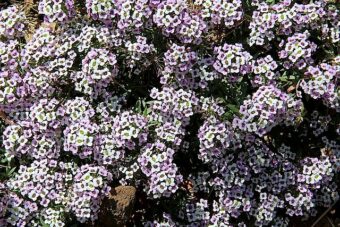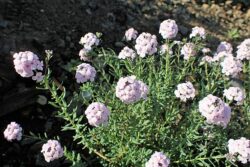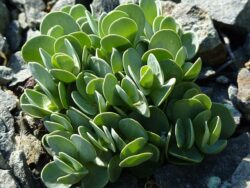Aethionema is a flowering plant that belongs to the Brassica family and has the common name of Stonecress. The genus itself has 60 species within them, where over 40 of them are found in Turkey.

The common name of stonecress comes about as the plant has a creeping habit as it normally grows on stony ground. The plant originates from the mountainsides in Europe and West Asia, where it normally grows in limestone rocks. It is normally a shrubby evergreen or semi-evergreen perennial with a mat of fleshy blue-green or grey leaves. On top of these leaves, sprays of tightly packed flowers heads appear.
Each flower head is a cluster of tiny 4 petals in each bloom that come in the lightest pink to the deepest rose colour. It only grows up to 30cm high and so will make a great addition to the container garden. Aethionemas are normally grown as said previously for their flowers but the linear leaves look good when the plant is not in flower.
The best way to think about Aethionemas is that they are similar to Iberis with a similar growth habit but less tolerant of wet soils. Let us find out how to grow Aethionema in containers.
GROWING AETHIONEMA IN CONTAINERS
You can either grow Aethionema from shop-bought plants or they are easy to grow from seeds.
GROWING AETHIONEMA FROM SEED

The best way to grow Aethionema is from seed. Sow them ten to twelve weeks before the last frost date in spring. To do this, fill a seed tray with a seed sowing compost and water well until the compost is moist. Gently on top, sprinkle the seeds thinly and cover them with a light layer of sieved compost. Place a propagator lid on top and place it in a warm place. After 30 days or so, the seeds will start to germinate.
Once the seedlings are large enough to handle, you can prick them out for transplanting into 7.5cm pots full of multipurpose compost. In mid-May, you can start hardening them off before planting outside in late May, this is recommended if you are growing annual species and also for perennials as they can be short-lived. This is the best way of growing new plants, although cuttings can be taken in early summer to add to your collection and to guard against losses.
PLANTING AETHIONEMA IN CONTAINERS
At this stage, you can treat shop-bought plants and home-reared seedlings in exactly the same way.
First, choose a low lying pot that has plenty of drainage holes. Fill it with a 1cm layer of gravel to help with drainage. Aethionema normally likes the soil to be alkaline as it represents their native growing conditions. To achieve this, mix a handful of garden lime into a container full of multipurpose compost. You will need to add this mixture to the container until it reaches 5cm from the rim.
Dig a hole in the growing media that is slightly bigger than the root ball it came in the original container. Drop the plant in so that the top of the root ball is at the same level as the top surface of the compost. Backfill with the growing media, so no gaps remain, as you may need to add more compost. Firm the plant in and water well.

Place the container in full sun, as it does not like to be in the shade. Water when5cm below the top surface of the compost feels dry to the touch, once established it will take drought pretty well but a must is that the compost is never soggy. Hence why drainage is very important.
They are not particularly hungry plants and what I recommend is that you give the plant an annual dressing with fish, blood and bone when the flowers start to form. For the perennial Aethionema, I recommend that in early spring, you give an annual dressing with a slow-release fertilizer.
You will need to cut spent spikes close to the leaves in autumn to neaten the plant. It can be a short-lived plant and so every summer I recommend that you take cuttings to propagate the plant. This will guard against losses and make sure that you can increase your stock.
PESTS AND DISEASES
In general, Aethionema tends to be disease-free but they can suffer from aphids. This is best dealt with by spraying with jets of water or if it is too bad you can spray with a suitable systemic insecticide. If you are growing them in a greenhouse, red spider mites can be a problem. Best dealt with by using a suitable systemic miticide.
VARIETIES TO GROW
The one genus you will likely find is based on Aethionema grandiflorum which has pale pink flowers.
‘Warley Rose’ has rose-red flowers, whilst a deeper shade of rose red can be grown if you choose ‘Warley Ruber’.
You may also find a small, dwarf species called Aethionema oppositifolium that produces pink flowers and only grow up to 5cm tall. ‘Kotsychi’ is a variety that produces pink flowers.
CONCLUSIONS
In this article, we have discussed how to grow Aethionema in containers. As you can see it is quite easy to grow, requiring very little in the way of care. You may not see them often in the garden but these beautiful flowers will fill those in need of pinks or reds in their container displays. All you need to do is grow them in alkaline compost and full sun.
If you have any questions or comments that you wish to make on growing Aethionemas in containers, please do so in the comment box below.
Happy Aethionema growing.
